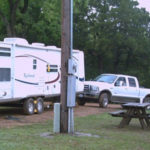Posted: 2/15/08
Team-based ministry changing church culture
By Jennifer Harris
Word &Way
Organization makes a huge impact on the effectiveness of a church’s ministries, consultants agree. the way leadership groups are organized—in committees or teams—may mean the difference between short-term obligation and long-term service.
Deserved or not, committees often have a negative connotation, said Don Simmons, owner of Creative Potential Consulting and Training.
| Some churches are shifting from "committee" terminology to a "team" concept. |
“The terminology and methodology is borrowed from government and corporate cultures,” Simmons said. “Committees have a reputation for long, boring meetings where little is accomplished and for structures that rarely take a person’s giftedness and passion into account, but rather their availability and inability to say ‘no.’”
While committees focus on tasks and agendas, ministry teams place emphasis on personal development and relationships, he insisted.
“Teams require a very human element—trust—that may not always be operable in committees,” Simmons said.
The team concept allows everyone to bring their ideas to the table, said Jim Dees, director of equipping ministries at Calvary Presbyterian Church in San Francisco, Calif. Instead of the top-down leadership of committees, teams give the freedom to brainstorm ideas.
Relationships mean longer active life for teams
The personal element generally means teams have a longer active life, as people often choose to serve longer when they have developed relationships.
“At First Baptist Church (Jefferson City, Mo.), committees are nominated by the enlistment committee and then voted on by the church to serve mostly 3-year terms,” said Jeanie McGowan, associate pastor of equipping at the church. “Teams are led by volunteer leaders, and they can enlist anyone they choose, and folks can serve for as long as they choose, making one-year commitments as they go along. You may serve on more than one ministry team, but we try not to have anyone serving on more than one committee at a time.”
At Calvary Presbyterian, mission teams are lay-driven. While a minister or member of the equipping team may come up with an idea, the new team quickly is passed on to a member of the congregation.
 |
Dees said the change to a team-based structure really changed the church’s ministry.
“It changed our church culture. Teams have greatly impacted the mobilization of people,” he said. “We’ve seen an increased number of church members involved in ministry in the community.”
Team-building requires commitment to a clearly defined mission, Simmons added.
“While some committees may function as teams, in order to build and sustain teams, leadership must be intentional and driven by a definitive purpose,” he said. “Teams do not happen accidentally—they are built with time, trust and tenacity.”
It took Calvary nearly two years to get the systems in place to start their equipping ministry, Dees said. The mission teams continue to evolve as new people get involved.
Changing an organizational structure takes time. Committees cannot—and should not—be changed into teams overnight. Simmons recommends changing one team at a time. “Start with the most obvious areas where teams may already exist, and then work to make them models for the rest of the church.”
Youth or student ministries may be a good place to start. Churches also may have worship or mission teams already functioning that can be a model for other changes.
Simmons emphasized that “a committee becomes a team through their behaviors, not just their language.”
The team that plays together, stays together
The next step in building a team is practicing essential relationship functions. “Good teams eat together, drink together, play together and pray together—usually in that order.” Simmons said.
One of the most joyful teams Simmons served on was designed to provide services for a large hospice facility.
“With deep respect for the patients, our team knew that it was important to sing, dance, laugh and joke with one another and with the hospice staff in the face of great pain,” Simmons said. “Our fun was contagious, and we were often asked to train other teams of volunteers about the need to ‘lighten up’ with one another, to encourage long-term service and to prevent burnout.”
The team’s laid-back nature wasn’t accidental, however. “The fun we had was evidence of our care for one another, and was borne out of time with each other outside of our service time,” Simmons said. “We shared meals often and committed enough time to knowing each other to be authentic with our joy.”
Another step Simmons recommends is putting together a team covenant. Covenants are designed by team members to provide relational boundaries and guidelines on how the team will function together. “Some believe that developing a covenant is useless time consumption, and if the covenant is not authentic and practical for the ministry team, then it may become just that,” Simmons said. “If the covenant is developed and written by the team, for the team and used intentionally, then the covenant can be the guidestar for the team’s work.”
Developing a covenant
Simmons gives six guidelines for developing a covenant that supports the work of a ministry team:
Sign up for our weekly edition and get all our headlines in your inbox on Thursdays
• Write the covenant as a team. Use time in the first two team meetings to develop the covenant, based on the “norms” the team needs to function.
• Keep the covenant focused on behaviors that are authentic and practical. Be sure to covenant areas such as attendance, punctuality, fun, contributions, conversations, confidentiality and documentation.
• Review the covenant at each team meeting. Allow for revision if a covenant area is being ignored or bypassed regularly.
• Discuss behaviors as a violation of the covenant, not as sin or personal disappointment.
• Review and re-covenant each time a new member joins the team to ensure ownership is understood and valued by the entire team.
• Write the covenant in everyday, authentic language. Even the Bible was written in the language of the ordinary person; so, church team covenants also should be easily understandable and accessible.
“A team covenant can make the difference between a cordial work group and a highly functioning team if the process of developing the covenant is authentic and realistic,” Simmons said. “The time invested in covenant creation will greatly benefit the team in fluidity and performance.”
Ultimately, Simmons believes teams benefit the church because “people matter. The fun that we have with one another exhibits to people that we are not only willing to share the work and tasks, but willing to share our very lives.”














We seek to connect God’s story and God’s people around the world. To learn more about God’s story, click here.
Send comments and feedback to Eric Black, our editor. For comments to be published, please specify “letter to the editor.” Maximum length for publication is 300 words.